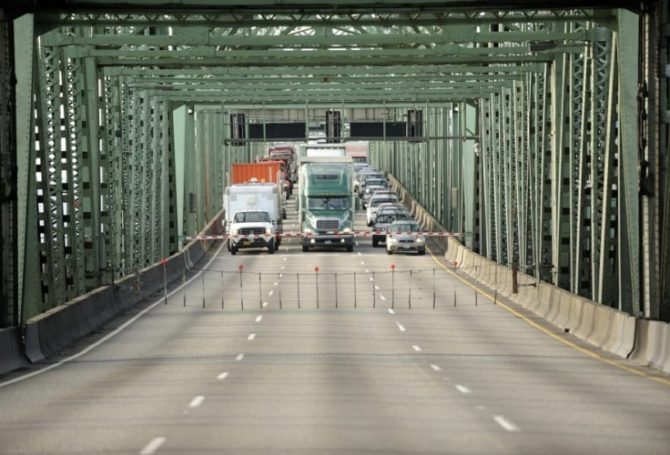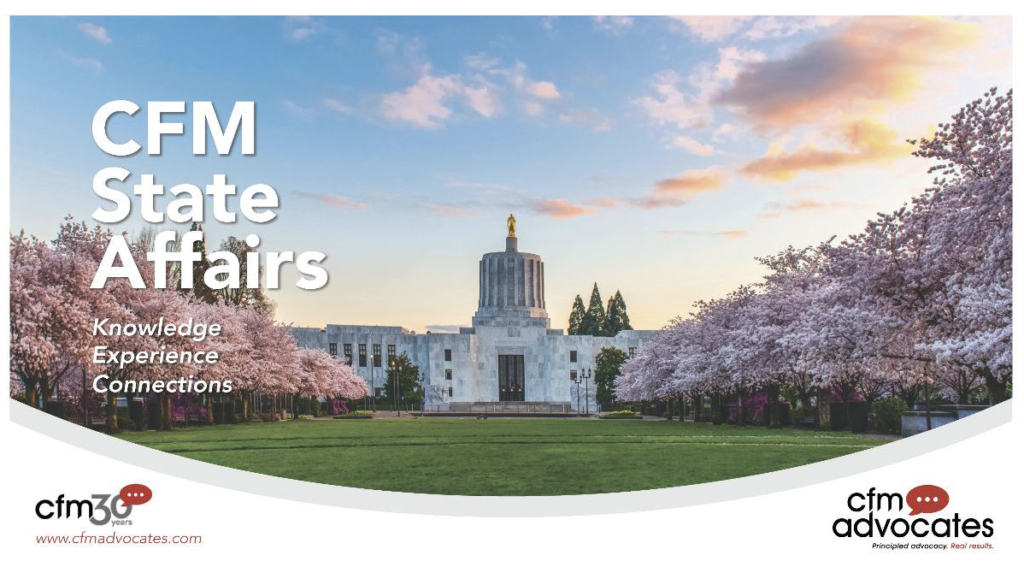
Oregon will receive $3.4 billion in federal aid for highways and $268 million for bridges over the next five years from formula funding contained in the $1.2 trillion Infrastructure Investment and Jobs Act awaiting President Biden’s signature, expected to come next week.
According to a fact sheet prepared by the White House, Oregon also will receive over five years $747 million to improve public transportation, $52 million to expand the state’s EV charging network, $100 million to boost broadband coverage, $39 million for wildfire prevention, $15 million to defend against cyberattacks, $211 million to update airports and $529 million to improve water infrastructure.
Travis Brouwer, assistant director of the Oregon Department of Transportation, said state officials have been looking at how to invest the additional federal financial assistance since September. “What I hope you see is the average Oregonian has more ways to get around, that it’s easier to hop on a bus or hop on a bike or walk safely through your neighborhood,” Brouwer said.
Targets for funding that Brouwer identified include mega-projects such as replacing the I-5 Columbia River Bridge and modernizing I-5 near the Rose Quarter, as well as fixing intersections with high fatality rates, repairing aging bridges and filling potholes.
The state and local governments could land even more funding from competitive grants authorized by the legislation. For example, the Columbia River bridge replacement project can compete for a chunk of the $12.5 billion Bridge Investment Program and the $16 billion set-aside for major projects that deliver substantial economic benefits to communities. Available federal funding will re-ignite the debate over replacing the bridge, including a light rail extension and tolling.
There is a $1 billion pot of money under supervision of Transportation Secretary Pete Buttigieg intended to promote “reconnecting communities”, a potential tie to the controversial Rose Quarter expansion project. Governor Brown has called for exploration of freeway expansion in a tunnel that would create space for redevelopment of the Albina district, which was severely disrupted when the freeway was built. Federal funding might pay for the substantially increased cost of Brown’s suggested approach.
Brouwer emphasized funding is provided in the legislation to address climate change. ODOT will be responsible for overseeing expansion of the EV charging network and creating a community charging program. Public transportation resources will be used in part to buy low or no-emission buses. Oregon is expected to apply for a portion of the legislation’s $2.5 billion discretionary EV charging fund.
A large portion of federal formula funds will come with few strings attached, which gives state and local officials leeway on how to deploy them. Roughly $200 million of the formula funds flowing to Oregon will be shared with local governments to pay for road and bridge improvements, community paths and safety projects.
The legislation goes beyond transportation to include $5 billion nationwide to help states deal with extreme weather and natural disasters. There is an additional $5 billion nationwide pot to help farmers cope with drought and maintain wildlife habitats in places such as the Klamath Basin. Another pot of money will assist tribal governments such as the Confederated Tribes of Warm Springs improve water quality on reservation lands. Broadband funding will be directed toward the more than 130,000 Oregonians who don’t have access or cannot afford to pay for it. There also is funding to increase resiliency of the nation’s power grid.
Comprehensive legislation like the Infrastructure Investment and Jobs Act don’t come along very often. In fact, infrastructure proposals have languished for years under both Democratic and Republican administrations, even though aging infrastructure is blamed in part for declining US economic competitiveness.
Biden has pushed hard for investment in physical infrastructure to address competitiveness and create good-paying construction jobs. The White House fact sheet says, “The historic Infrastructure Investment and Jobs Act will make life better for millions of Oregon residents, create a generation of good-paying union jobs and economic growth and position the United States to win the 21st century.” Brouwer echoed that sentiment. “We want to show Oregonians the benefits they’ll see from this legislation very quickly.”
We want to show Oregonians the benefits they’ll see from this legislation very quickly.
As federal funding flows quickly to Oregon and other states, several advisory groups will assist ODOT in determining project priorities. Decision-making on timing will be influenced by serious product shortages, supply chain delays and inflated prices, as well as deadlines for submission of discretionary grant applications.
Because the legislation addresses such a wide range of physical infrastructure investments, it isn’t easily summarized or readily understood by the public. Talk of trillions, billions and millions of dollars can be mind-boggling, even for experts. CFM Partner Joel Rubin provided a detailed overview of the Infrastructure Investment and Jobs Act in an Under the Dome blog posted earlier this week. In addition, here is a breakdown of the various programs that will provide the majority of formula funding to Oregon:
The $3.4 billion highway formula funding would mainly come through these programs:
- National Highway Performance Program (NHPP; FAST Act §1106) NHPP is the largest of the federal-aid highway programs. It supports improvement of the condition and performance of the National Highway System (NHS), which includes Interstate System highways and bridges, as well as virtually all other major highways
- Surface Transportation Block Grant Program (STBG; FAST Act §1109) STBG is the federal-aid highway program with the broadest eligibility criteria. Funds can be used on any federal-aid highway, on bridge projects on any public road, on transit capital projects, on routes for nonmotorized transportation and on bridge and tunnel inspection and inspector training
- Highway Safety Improvement Program (HSIP; FAST Act §1113) HSIP supports projects that improve the safety of road infrastructure by correcting hazardous road locations, such as dangerous intersections, or making road improvements, such as adding striping. HSIP funds may also be used for road safety projects not on federal-aid highways.
- Congestion Mitigation and Air Quality Improvement Program (CMAQ; FAST Act §1114) CMAQ was established to fund projects and programs that may reduce emissions of transportation-related pollutants.
- National Highway Freight Program (NHFP; FAST Act §1116) This program is to help states and MPOs remove impediments to the movement of goods. Section 1116 requires FHWA to establish the National Highway Freight Network (HFN), made up of the primary highway freight system, critical rural freight corridors, critical urban freight corridors and any Interstate System highways not so designated.
The $268 million for bridge replacement and repair would come through the following:
- Bridge Formula Program – The bill appropriates $27.5 billion for a new bridge formula program to provide funding to Statesand Tribal governments to repair and rebuild bridges in poor condition. To help counties andlocal governments that struggle to pay for costly bridge projects, 15 percent of funds will be set aside for “off-system bridges” including projects on locally owned facilities that are not on theNational Highway System.
The $747 million in public transportation dollars would mainly come through these programs:
- Urbanized Area Formula Program (49 U.S.C. §5307) The Urbanized Area Formula Grants Program provides funding for public transportation in urbanized areas. Funding can be spent on capital, planning, job access and reverse commute projects and, in some circumstances, operating expenses.
- State of Good Repair Grant Program (49 U.S.C. §5337) The State of Good Repair (SGR) Program provides funding primarily for repairing and upgrading rail transit systems, but also other fixed-guideway systems (such as passenger ferries and bus rapid transit) and bus systems that use high-occupancy-vehicle (HOV) lanes.
- Rural Area Formula Program (49 U.S.C. §5311) The Rural Area Formula Program provides funding to states and Indian tribes for public transportation outside of urbanized areas. Capital, operating and planning are all eligible expenses.
- Bus and Bus Facilities Grant Program (49 U.S.C. §5339) The Bus and Bus Facilities Grant Program provides funding for capital expenses to purchase and rehabilitate buses and to construct bus-related facilities, such as maintenance depots. Funding through this program is split between a formula program, a competitive program and a third tailored competitive program for low- and no-emission projects.
Related articles
- https://www.opb.org/article/2021/11/05/us-infrastructure-spending-plan-oregon-transportation-odot-wildfires-drought/
- https://oregoncapitalchronicle.com/2021/11/08/oregon-transportation-officials-already-at-work-planning-to-spend-new-billions/




